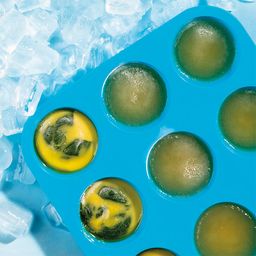Freeze with Ease
Saving money doesn’t end at the store. These helpful tips for freezing and thawing will make the most of your food and stretch your dollar further.

Freezing Tips

Freeze individual bags of bread for quick and easy sandwich assembly when packing lunches for school or work!

Ice cube trays and muffin tins can be used to freeze individual portions of broth or tomato sauce (or paste). Just melt them in a stock pot before adding ingredients when making your favorite recipes!

You can also use muffin tins or ice cube trays to preserve fresh herbs for cooking by freezing in water, oil or melted butter. When you’re ready to cook, just add to the skillet and watch the flavors melt into your dish!

To avoid freezer burn: cool food completely in the refrigerator before adding to the freezer, flatten and release air from freezer bags and make sure your bag or container is tightly sealed!

- Never defrost food at room temperature.
- Use the refrigerator, submerge in cold water or defrost in the microwave depending on how quickly you need to thaw your food.
- You can refreeze food once it has been cooked. However, you should never place an uncooked item back in the freezer after thawing.
To Freeze or Not to Freeze
These foods do not fare as well as others in the freezer.
- Gravies and creamy sauces
- Fruits and vegetables with high water content: celery, cucumbers, lettuce, watermelon, etc.
- Fully cooked pasta
- Dairy products such as yogurt, soft cheeses and sour cream
- Raw and hard-boiled eggs
- Anything carbonated
- Soft herbs like cilantro and basil (can still be frozen in water, oil or butter.)

Storage Tips
- Divide leftovers among individual containers and freeze for quick meal options later. Simply Done storage bags and containers are a budget-friendly option for freezer storage!
- Label everything with the date and type of food so you know what it is and when to use it by.
- Wrap meat and seafood in plastic wrap for a tight seal.
- Cut down on prep time later by adding uncooked meat to a marinade before freezing.
- Freeze produce in a single layer on a sheet pan before adding to containers so it doesn’t freeze together.
- The earlier you freeze, the better—you can’t save food that’s past its prime. Chop large produce and freeze in small quantities, but leave a little room inside the container (food will expand).
How Long Will It Last?
Bacon and sausage
1 to 2 months
Casseroles
2 to 3 months
Egg whites or egg substitutes
Up to 12 months
Frozen dinners and entrées
3 to 4 months
Soups and stews
2 to 3 months
Ham, hot dogs and lunch meats
1 to 2 months
Steaks, uncooked
Up to 12 months
Chops, uncooked
4 to 6 months
Roasts, uncooked
Up to 12 months
Beef and pork, uncooked ground
3 to 4 months
Beef and pork, cooked
2 to 3 months
Poultry, uncooked whole
12 months
Poultry, uncooked parts
9 months
Poultry, cooked
4 months
Produce
8 to 12 months